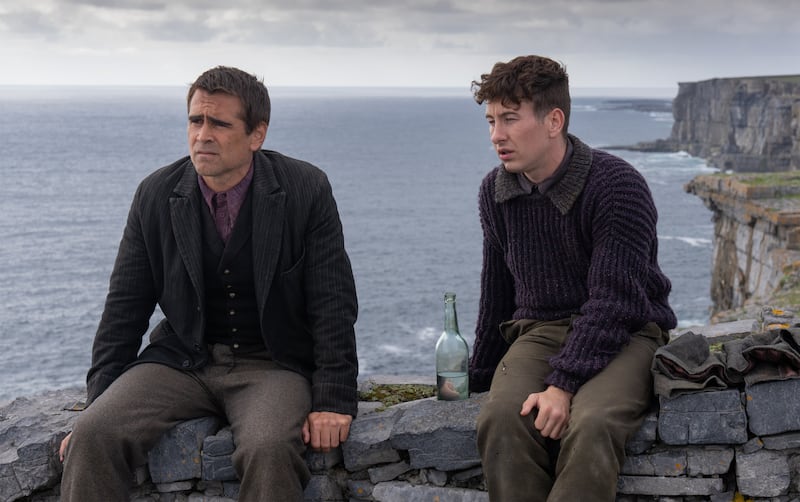So about the 2023 Oscars ...
Wait! Come back.
There is a point to be made and it has to be made early before expectations turn to ash at our hubristic feet. Irish actors look set to have their best year at the Academy Awards. At time of writing, four domestic performers seem likely to secure nominations. Five is a strong possibility. Six is by no means out of the question.
Here’s the skinny. Most awards boffins believe Colin Farrell and Brendan Gleeson, stars of The Banshees of Inisherin, will land in respectively best actor and best supporting actor. Kerry Condon from the same film is likely to figure in best supporting actress. Jessie Buckley, part of an ensemble cast in Sarah Polley’s Women Talking, will surely be up against Condon in that race. Barry Keoghan is on the penumbra of the supporting-actor five for Banshees. Paul Mescal, one of only two men among the 10 nominees for best lead performance at the influential Independent Spirit Awards, is looking a decent outside bet for a best actor place for Charlotte Wells’s Aftersun.
READ MORE
One cannot escape the blaring qualification that one film provides the lion’s share of potential nominees. Take away Banshees and we are in promising, rather than potentially spectacular, territory, but it is worth stressing that Farrell and Gleeson have long been mentioned as potential Oscar nominees. Keoghan has been marked down as a plausible future candidate since his breakout in The Killing of a Sacred Deer in 2017. Condon is better known for TV and stage work (despite a recurring Marvel presence), but, if nominated, will seem comfortable in the company.

The nation is coming down with regular Oscar contenders. Saoirse Ronan has been nominated four times. Ruth Negga has one nod and should have had a second last year for Loving. If Buckley scores, it will her second shortlisting in a row. Michael Fassbender has been “up” twice. Acclaimed and employable Irish actors buzz around the highest levels of the Hollywood content complex. Oscar bores are already pencilling in Cillian Murphy for his lead role in next year’s Oppenheimer. And so on.
Yet it was not always so. In conversations surrounding The Banshees of Inisherin, both Farrell and Gleeson, while acknowledging the work of predecessors, admitted that neither grew up thinking Hollywood an obvious destination for the Irish actor.
[ When Brendan Gleeson met Colin Farrell: ‘We hit it off - in a fundamental way’Opens in new window ]
Talking to me at the Venice Film Festival, the two men noted how the younger Keoghan arrived with a different attitude. “Theatre for you was still a thing,” Gleeson said to Farrell. “Barry was purely cinematic from the very beginning. That, for me, is the difference in terms of the generation we now have. We didn’t start off being cinematic.”
We now have a dozen or so actors who could be classed as genuine movie stars – the sort of people who get yelled at on red carpets. Decades went past with only two or three meeting the definition. The reputation of Irish acting always remained high. No thinking person would say a word against the likes of Siobhán McKenna or Donal McCann or Colin Blakely. But, until the current century, it remained something of an event to see an Irish actor at the front of a marquee movie. “Jesus! Is that your man out of The Riordans?” we didn’t exactly say when Gabriel Byrne turned up in Miller’s Crossing. But it certainly made our chests swell a little.
The movie industry has, like every other area of popular culture, become more international over the past few decades. Some columnist in Australia could be writing the same column about his own nation
Barry Fitzgerald became one of the great character actors, but leads were vanishingly rare. Just look at those nominated for best actor throughout the last century. Richard Todd? A movie star, but rarely remembered as Irish. Dan O’Herlihy? A great actor, but not a top-rank star. Richard Harris in 1963 for This Sporting Life? Now we’re talking.
Yet there was not another Irish nominee in that race until Kenneth Branagh and Daniel Day-Lewis (tricky one, as he was not yet an Irish citizen) registered in 1989. Astonishingly, Ronan, in 2015, became the first Irish woman to be nominated for best actress.
What changed? It helped that the country’s film and TV industries grew as a force. Drama schools paid attention to screen acting. But there was a wider factor. The movie industry has, like every other area of popular culture, become more international over the past few decades. Some columnist in Australia could be writing the same column about his own nation. Movie stars from that continent were, after all, once just as rare. Now your Margot Robbies and your Liam Hemsworths are unavoidable. Cate Blanchett is favourite for the upcoming best actress Oscar. Hugh Jackman was inked in for a best actor nomination, but seems to be losing ground in that fifth spot to ... well, one Paul Mescal.
This is where we came in. Let us say no more for a month or two. We wouldn’t want to jinx it.















